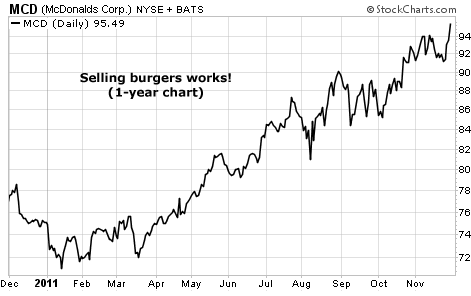| Home | About Us | Resources | Archive | Free Reports | Market Window |
Why Everyone Is Wrong About the American Oil BoomBy
Thursday, December 1, 2011
This year, an army of financial analysts has come forward to estimate how big the coming boom in U.S. oil production will be.
As you surely know by now, new technologies have allowed us to access massive, previously undiscovered shale fields... fields that will allow us to produce an incredible amount of energy.
But what you don't know is all those analysts will almost surely be proven wrong.
The amount of new oil that will be produced can't even yet be imagined. Trust me on this... every projection you've seen this year – and those that will be made over the next 12-24 months – about the amount of future oil production will end up being woefully, laughably conservative.
My bet is U.S. production at least triples over the next 10 years... which will create an enormous amount of wealth for investors.
How do I know? Because that's what always happens with oil discoveries.
Somewhere out there an elephant is hiding in the shale. Who knows who will find it... but if we drill enough holes out there, someone will. Consider this...
Last month, Anadarko announced it had discovered what it believes will be a 1 billion-2 billion-barrel resource in the Niobrara shale that sits under the Wattenberg field in northeast Colorado. That's the largest new discovery in the U.S. in more than 40 years. Anadarko drilled 11 horizontal wells to make this discovery. Next year, it will drill 160 more. And in the future, it will drill 1,200-2,700 horizontal wells in the Wattenberg field. My bet is, the resource estimate continues to get bigger.
Now, consider this. The Wattenberg field has been in production since 1901. Yes, that's correct. It's not a typo. The field has already produced 4 trillion cubic feet of natural gas and hosts 14,000 wells. In 2007, it produced 11 million barrels of oil.
The geology of Wattenberg is well understood. This was an old field – something that had been picked over by every major oil company in the U.S. for decades. The accepted wisdom said nothing new was to be found there... until Anadarko found another 1 billion barrels of oil... or maybe 2 billion.
New drilling technologies – such as hydraulic fracturing (fracking) and horizontal drilling – won't merely allow the discovery of many large, new oil fields, they will also completely reshape the production curves of existing fields. That's a big part of the equation that most people haven't figured out yet. New technologies won't just bring new fields into production, they will revive our existing fields. Many older fields may even surpass their previous total production.
Of course, no one knows exactly how much more oil and gas will be discovered. Looking at what his firm has found so far, Anadarko's CEO says total American production will double in 25 years. "The resource is there, and the technology is there."
And according to Greg Armstrong, chairman and CEO of the Plains All American Pipeline company, a $16 billion partnership with a 16,000-mile network of onshore pipelines...
Goldman Sachs came out with its forecast this week, too. It now says America will be the world's largest crude oil producer by 2017 – surpassing even Saudi Arabia.
All this is no surprise to my regular readers. In April 2010, I wrote several things that, at the time, I knew no one would believe...
Quite simply... after the Internet and the associated technologies... this is the biggest investment opportunity of my lifetime.
What's happening here is bigger than just one or two oil companies having some success. It's even bigger than the Eagle Ford play. We are in the midst of a massive, global discovery and expansion phase for oil and gas. And in tomorrow's essay, I'm going to show you what two things in particular make this phase so powerful... and what all this means for you as an investor.
Good investing,
Porter
Further Reading:
For investors looking for exposure to the upside of shale oil, resource expert Matt Badiali offers one of his favorite names.
"Investors who get in the right companies today could double their money within three years as production ramps up."
This shift "will mean billions of dollars in profits spreading through the energy sector." Larsen Kusick shares his favorite companies to profit from this trend.
Market NotesDAILYWEALTH READERS PROFIT FROM ANOTHER "BASICS" RALLY If there's one point we hope we've driven home this year, it's how well "owning the basics" works in a tough market... or any market.
Regular DailyWealth readers have read about our "basics" idea dozens of times. The idea is, for long-term investors – especially folks who want exposure to the growing economies of Asia, Africa, and Latin America – boring, basic, dividend-paying companies are the way to go. These companies sell things like soda, cigarettes, beer, and Band-Aids. It's in the "basics" business that you can find companies with powerful brand names producing huge and predictable cash flows. After all, no new gadget is going to make having a beer after work obsolete.
Just after the August panic, we highlighted how many of our favorite "basic" stocks sailed through the crisis with minimal share price damage. They simply kept selling their products every day and kept paying rising dividends. And just this week, several have staged major upside breakouts.
For an example of this price strength, we note McDonald's... a stock our colleague Tom Dyson pegged as an ultimate "recession-proof" company years ago. McDonald's isn't inventing the next smartphone or social network. It simply sells burgers and pays dividends. And as you can see, this strategy is working. McDonald's just hit a fresh 52-week high.
 |
In The Daily Crux
Recent Articles
|


